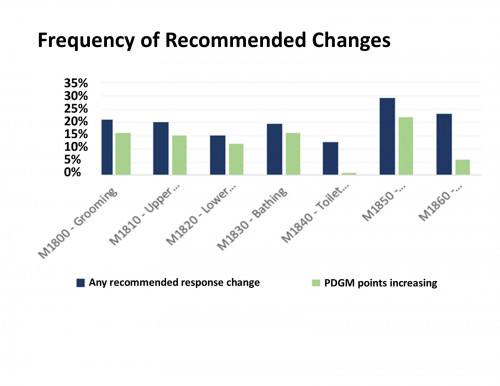Home health clinicians may benefit from additional training in answering OASIS questions related to a patient’s ability to manage oral medications and make safe transfers from bed to chair or toilet, according to the most recent client data examined by SimiTree data analysts.
SimiTree analysts sifted through 120,000 OASIS reviews completed by SimiTree coding & OASIS review specialists in 2022 to see which items were most often returned to clients with recommended scoring corrections based on supporting information in the patient’s chart.
Problems with OASIS scoring for oral medication management and safe transfer topped the list of most frequently recommended changes, indicating clinicians may not fully understand current OASIS guidance or the intent of these questions, according to Christine Lang, SimiTree Director of Data Analytics.
“Even experienced clinicians can struggle with the nuances of OASIS guidelines or miss responses that are inconsistent within an assessment or when cross-referenced against other patient documentation,” Lang said. “The perspective of an outside expert, someone who is focused on keeping up with the latest guidance and is not distracted by the myriad of tasks your clinicians are responsible for every day, can be a safety net for ensuring accuracy in patient documentation, reimbursement, and quality scores.”
In addition to the management of oral medications and transferring, two other troublesome items for clinicians identified in SimiTree’s analysis were grooming and toileting hygiene. SimiTree OASIS specialists recommended clinicians make scoring changes on those four items in more than 20 percent of reviews conducted.
OASIS scoring impacts reimbursement
Correctly scoring the OASIS is important for payment as well as capturing and reporting the patient’s status at start of care and outcome at discharge. OASIS scoring directly impacts reimbursement for the care and services an agency provides.
With the simultaneous launch of OASIS E and the new Home Health Value-Based Purchasing Model on Jan. 1, many agencies are placing new emphasis on OASIS accuracy, recognizing that training delivers more accurate reimbursement.
Key OASIS items measuring a patient’s functional impairment factor into an agency’s reimbursement under Medicare’s PDGM payment model. Some OASIS measures will also count toward an agency’s total performance score under VBP, further impacting payment amounts in 2025.
“OASIS responses are used to drive PDGM payment, determine outcome scores, calculate risk adjustment values, and feed into your PEPPER reports,” Lang said.
Common OASIS scoring problems
Lang said SimiTree’s OASIS specialists frequently identify issues with scoring on OASIS items used for PDGM calculation.
“In nearly 90 percent of our OASIS start of care assessments, SimiTree reviewers suggested at least one change to OASIS items that are part of PDGM functional calculations,” she said.
“Across all assessment types involving PDGM calculations, we are most likely to find erroneous responses in M1850 – Bed Transferring, resulting in an increase to functional points in 22% of the reviews we conducted,” she said.
Transferring occurs when a patient moves from a supine position in bed to a sitting position bedside. Some type of standing, stand-pivot or sliding board transfer to a chair may also be assessed as part of a transfer. Toilet transferring includes the patient’s ability to safely get to and from and transfer on/off the toilet.
Frequent points of confusion for clinicians that may impact M1850 scoring include failing to fully assess patient safety in transferring, or considering devices available for use by the patient as part of the assessment. Those misunderstandings and others often lead clinicians to underscore the patient’s functional impairment.
“Underscoring a patient on OASIS items may lead to reimbursement rates not sufficient to cover the cost of the care of that patient, may limit your ability to demonstrate the quality of care you are providing, and may ultimately contribute to lower future payment rates,” Lang said.
SimiTree offers OASIS training
SimiTree consultants recommend full OASIS training for accuracy, especially with the implementation of OASIS-E creating new challenges and misunderstandings in 2023. Our OASIS experts are available for both onsite and remote OASIS training sessions to address any or all areas where clinicians are experiencing difficulty.
“It’s important to ensure your clinicians fully understand OASIS conventions and specific item exclusions,” Lang said. “It’s also a good idea to review your assessment process, both at start of care and discharge, to make certain clinicians understand how to correctly conduct the assessment.”
SimiTree OASIS specialists are working with many agencies to focus on the OASIS measures which will count toward total performance scores under VBP. Our clinical operations and financial experts demonstrate how to forecast payment adjustments under VBP based on the new Pre-Implementation Performance Reports (PIPR) CMS has recently made available. SimiTree consultants help agencies develop corrective action plans in areas where improvement may be needed.
Use the form below to start the conversation about how SimiTree can improve OASIS scoring for your agency, or to discuss outsourcing OASIS review to our coding and OASIS specialists.
Are you an Insider?
Our free monthly report offers industry insight and analysis from SimiTree experts. Sign up here to get helpful articles like this one in your inbox each month.

